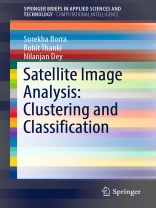Thanks to recent advances in sensors, communication and satellite technology, data storage, processing and networking capabilities, satellite image acquisition and mining are now on the rise. In turn, satellite images play a vital role in providing essential geographical information. Highly accurate automatic classification and decision support systems can facilitate the efforts of data analysts, reduce human error, and allow the rapid and rigorous analysis of land use and land cover information. Integrating Machine Learning (ML) technology with the human visual psychometric can help meet geologists’ demands for more efficient and higher-quality classification in real time.
This book introduces readers to key concepts, methods and models for satellite image analysis; highlights state-of-the-art classification and clustering techniques; discusses recent developments and remaining challenges; and addresses various applications, making it a valuable asset for engineers, data analysts and researchers in the fields of geographic information systems and remote sensing engineering.
Tabella dei contenuti
Preface.- Introduction.- Image Pre-processing Techniques.- Satellite Image Clustering.- Satellite Image Classification.- Applied Examples.- Conclusion.
Circa l’autore
Surekha Borra is currently a professor at the Department of Electronics and Communication Engineering and chief research coordinator of KS Institute of Technology, Bangalore, India. She earned her doctorate in the copyright protection of images from Jawaharlal Nehru Technological University, Hyderabad, India. Her research interests include image and video analytics, machine learning, biometrics, biomedical signals, and remote sensing. She has filed one Indian patent and published seven books, sixteen book chapters, and several research papers in refereed and indexed journals, and in the proceedings of international conferences. She has received several research grants and awards from professional bodies and the Karnataka state government of India, including a Distinguished Educator & Scholar Award for her contributions to teaching and scholarly activities, and a Woman Achiever’s Award from the Institution of Engineers (India) for her prominent and innovative research.
Rohit Thanki earned his Ph D in multibiometric system security using the compressive sensing theory and watermarking from CU Shah University, Gujarat, India, in 2017. His research interests include digital watermarking, the biometrics system, security, compressive sensing, pattern recognition, and image processing. He has published seven books, seven book chapters, and more than 25 research papers in refereed and indexed journals, and has participated in conferences at the national and international level. He currently serves as a reviewer for journals published by the Institute of Electrical and Electronics Engineers (IEEE), Elsevier, Taylor & Francis, Springer, and IGI Global.
Nilanjan Dey is an Assistant Professor at the Department of Information Technology, Techno India College of Technology, Kolkata, India. He was an honorary Visiting Scientist at Global Biomedical Technologies Inc., CA, USA and an associated Member of the University of Reading, London, UK. He has authored or edited more than 40 books with Elsevier, Wiley, CRC Press and Springer etc., and published more than 300 research articles. He is Editor-in-Chief of the International Journal of Ambient Computing and Intelligence, IGI Global, USA. He is the Series Co-Editor of Springer Tracts in Nature-inspired Computing; Advances in Ubiquitous Sensing Applications for Healthcare; and Intelligent Signal Processing and Data Analysis; as well as an Associated Editor for IEEE Access. His main research interests include medical imaging, machine learning, data mining etc. Recently, he was selected as one of the top 10 most published and cited academics in the field of Computer Science in India during the period of consideration 2015-17.












